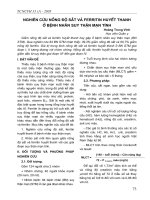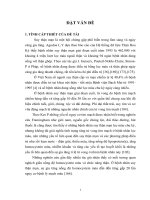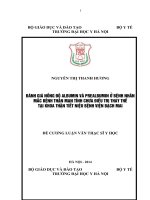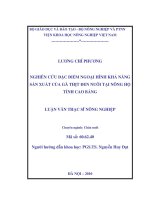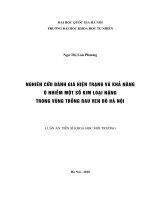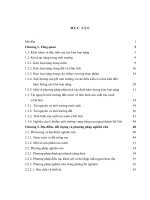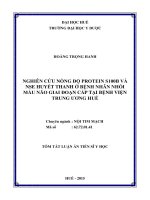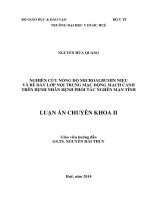Nghiên cứu nồng độ sắt, ferritin và khả năng gắn sắt toàn phần trong huyết tương ở bệnh nhân bệnh thận mạn tính chưa điều trị thay thế thận tt tiếng anh
Bạn đang xem bản rút gọn của tài liệu. Xem và tải ngay bản đầy đủ của tài liệu tại đây (174.92 KB, 24 trang )
1
INTRODUCTION
Chronic kidney disease (CKD) is increasing rapidly in the world as
well as in Vietnam due to the rapid increase of kidney damage causes
such as diabetes and hypertension. Based on the changing of glomerular
filtration rate, chronic kidney diseases are divided into five sequential
and successive stages. From stage 3 to stage 5 of chronic kidney disease
(glomerular filtration rate < 60 ml/min) is considered as chronic renal
failure. When glomerular filtration rate < 15 ml / min, patients need
kidney replacement therapy such as hemodialysis or kidney
transplantation.
Anemia is common in patients with chronic kidney disease. Anemia
is often caused by a combination of three causes: dysfunction of
hematopoietic organs, lack of hematopoietic materials and bleeding, in
which lack of erythropoietin and iron deficiency are two important
factors. Iron deficiency oftens occurs in patients with renal failure
(glomerular filtration rate < 60 ml/min). Patients with end stage chronic
kidney disease often have high proportion of iron deficiency, but in
hemodialysis patients, iron overload often occurs. Both situations
affects to the quality of anemia treatment in this group of patients.
As the recommendation of the National Kidney Foundation Disease
Outcomes Quality Initiative (NKF-K/DOQI), to treat anemia effectively
in patients with chronic kidney disease, besides providing
erythropoietin, patients should be supplemented with amino acids, trace
elements and iron in particular. In patients with chronic kidney disease,
it is necessary to determine the status of serum iron storage and its
classification: iron deficiency, enough iron and iron overload. This
recommendation also mention that sufficient iron compensation should
be based on ferritin and transferin saturation. Transferrin saturation is
calculated through serum iron and Total Iron Binding Capacity (TIBC).
Thus, there are three most necessary quantities to assess iron deficiency
status: iron, ferritin and TIBC.
In Vietnam, there have been many studies on the status of serum iron,
ferritin and transferrin in patients with chronic renal failure, but there have
not been many studies that mention to TIBC and the status of iron storage
which is recommended by the K/DOQI in patients with chronic kidney
disease who have not undergoing renal replacement therapy. For the above
reasons, we conducted the study "Study on the concentration of
2
plasma iron, ferritin, and total iron binding capacity in chronic
kidney disease patients without renal replacement"
1. Objectives of the study
The study was conducted in patients who were diagnosed with chronic
kidney disease (glomerular filtration rate < 60 ml/min) and had not been
treated with kidney replacement therapy in the Department of Nephrology
and Hemodialysis, Military Hospital 103, with the following two
objectives:
- Describe the characteristics of anemia, the concentration of plasma
iron, ferritin, TIBC and assess the status of iron storage according to the
KDIGO in stage 3 to 5 chronic kidney disease patients without renal
replacement.
- Determine the relationship between concentrations of plasma iron,
ferritin, TIBC, the iron storage status with some characteristics of chronic
kidney disease patients without renal replacement.
2. The urgency of the study
Anemia is a common manifestation in CKD patients, especially in
patients with GFR < 60 ml/min (renal failure). The mechanism of
anemia in CKD patients involves Erythropoietin deficiency and lack of
hematopoietic materials including iron. Iron supplementation for
anemia treatment in CKD patients requires a scientific basis and is a
difficult problem for clinicians.
As the recommendation of the World and Vietnam Kidney
Association, it is necessary to determine the status of iron storage before
iron compensation. Assessment of iron status should be based on serum
ferritin concentration and transferin saturation, in which transferin
saturation is calculated by serum iron and TIBC concentrations. Thus,
the study on the concentration of iron, ferritin and TIBC, thereby
determining the status of iron storage in CKD patients who have not
been treated by kidney replacement therapy, is a necessary study for
clinical practice.
3. New contributions of the thesis
This is the first study in Vietnam that quantifies serum TIBC
concentration, that recommended by the Kidney Associations to use
along with serum iron and ferritin concentrations to assess the iron
storage status of CKD patients who have not been treated by kidney
replacement therapy. The results of the study confirmed that mean value
of serum TIBC concentration in CKD patients was lower than that of
3
normal control group. The results also showed high proportion of
patients with lack of iron storage. There are some factors related to
TIBC and iron storage reduction. Based on this results, clinicians will
have a strategy to compensate for iron, improve the effectiveness of
anemia treatment for patients with chronic kidney disease.
4. Thesis structure: The thesis includes 116 pages. Introduction: 2
pages, literature review: 34 pages, subjects and methods: 16 pages,
results: 30 pages, discussions: 31 pages, conclusions and
recommendations: 3 pages. In the thesis, there are 43 tables, 14 charts, 1
diagram, 2 pictures. The thesis has 136 references, including 21
Vietnamese and 115 English references.
Chapter 1: LITERATURE REVIEW
1.1. Anemia in patients with chronic kidney disease
According to the World Health Organization, anemia is a
condition that reduces circulating hemoglobin in peripheral blood below
normal levels of people with the same sex, age and in the same living
environment. According to International Society of Nephrology, in
patients with chronic kidney disease, anemia was diagnosed when Hb <
130g/l for men, Hb < 120g/l for women and Hb < 110g/l for pregnant
women.
1.2. Assessing the status of iron storages in patients with chronic
kidney disease
Clinically, there are many indicators assessing iron function of
healthy people, CKD and kidney failure patients. KDOQI and KDIGO
recommend some commonly used indicators such as serum iron,
ferritin, transferin, TIBC concentration and transferrin saturation
(TSAT).
To assess the status of iron storage, International Society of
Nephrology recommends that we mostly based on ferritin and TSAT.
Calculation of TSAT according to the following formula:
Plasma iron (µmol/l) x 100
TSAT (%) = -------------------------------------Plasma TIBC (µmol/l)
+ Absolute iron deficiency:
- CKD patients who have not been treated by kidney replacement
therapy: Plasma ferritin concentration < 100ng/ml and/or serum
transferrin saturation level < 20%.
- Patients with hemodialysis: Plasma ferritin concentration < 200
4
ng/ml and/or serum transferrin saturation level < 20%.
+ Functional iron deficiency: plasma ferritin concentration ≥
200ng/ml and/or serum transferrin saturation level < 20%.
+ Iron overload in CKD patients who have not been treated by
kidney replacement therapy: serum ferritin concentration ≥ 500ng/ml
and/or TSAT ≥ 50%
1.3. Studies on concentrations of serum iron, ferritin and TIBC in
CKD patients.
+ In the world, there had been many studies on the use of serum
TIBC, iron and ferritin concentrations to assess iron storage status in
patients with and without dialysis. Numerous studies had evaluated the
results of iron compensation in anemia treatment in patients with
chronic kidney disease.
+ In Vietnam: there were some studies on serum iron and ferritin
levels, however, there had been no studies on TIBC and iron storage
status in chronic renal failure patients who have not been treated by
kidney replacement therapy.
Chapter 2: SUBJECTS AND METHODS
2.1. Subjects
The study was conducted on 190 subjects who was divided into 2
groups:
- Study group: 124 patients with stage 3 to 5 chronic kidney disease,
who have not been treated by kidney replacement therapy (GFR < 60
ml/min), at the Department of Nephrology and Hemodialysis, Military
Hospital 103.
- Normal control group: 66 healthy people.
- Research period: 01/2014 – 04/2018.
+ Inclusion criteria
- Control group: healthy adults who do not have kidney or urinary
diseases, agree to participate in the study.
- Study group: Patients with stage 3 to 5 chronic kidney disease who
have not been treated by kidney replacement therapy, age of 16 years
old and above, agree to participate in the study.
+ Exclusion criteria
- Control group: Acute blood loss within the previous 3 months or
bleeding. People who are pregnant or have just given birth within the last 6
months.
- Study group: Blood transfusion during the previous 3 months.
5
Acute blood loss within the previous 3 months or bleeding during the
study period. Patients have been taking iron or iron preparations.
Patients have an indication for emergency dialysis.
2.2. Methods
- A descriptive, cross-sectional, comparative case-control study
- Sample size calculation:
Percentage of patients with chronic renal disease with iron
deficiency from 54.4% to 63.5% in previous studies. Calculation of the
sample size according to the following formula:
(Z1-α/2)2 x p (1-p)
n = ----------------------D2
In which: Z = 1,96, with a reliability of 95%
p = 0,544 (lowest value in previous studies)
D = 0,1, the desired accuracy.
According to the calculation, the study must have at least 96 patients.
In the study, n = 124 patients were used.
2.2.1. Study targets
Patients admitted to hospital, were asked for medical conditions
and were taken medical examination according to the research form.
The following criteria were collected:
- Age, gender, history of disease
- Measuring for blood pressure, height, weight and BMI calculation.
- Laboratory tests include: hematology, biochemistry (glucose, urea,
creatinine, albumin, uric acid, four blood lipid indices, electrolytes, hsCRP...)
- Quantitative determination of plasma iron, ferritin, and TIBC levels:
venous blood was taken when patients were hungry in the early
morning. Plasma iron and ferritin concentration were quantified on
Cobas 6000 system, which using the kit of Roche company, in
Department of Biochemistry, Military Hospital 103. Serum TIBC
concentration were quantified by ELISA method at Department of
Pathophysiology, Vietnam Military Medical University for both study
and control groups.
- Calculating glomerular filtration rate under the guidance of NKFK/DOQI using the MDRD formula which was based on creatinine, age,
gender and race.
- Calculation of transferrin saturation by plasma iron and TIBC
6
concentrations.
- The iron storage status was divided base on the recommendation of
KDIGO and KDOQI throughout the ferritin and TSAT indices.
- The diagnostic, classification and evaluation standards were based on
recommendations of national and international specialized associations.
- Evaluation of increasing or decreasing plasma iron, ferritin and TIBC
levels were based on control group results.
2.2.2. Data processing
- The data was processed according to the medical statistical method
using SPSS software program version16.0.
- The algorithms were used include: multivariate logistic regression
analysis, calculating mean values, standard deviations, percentages,
comparing two average values and percentage by t-test, compare ratios
by Chi-square test, comparing mean values by Anova test, calculating
the correlation coefficient (r).
2.2.3. Ethics in research
- The study did not violate ethics in medicine, serving for screening for
chronic kidney disease patients.
- The study was approved by the Department of Heart - Kidney - Joints
- Endocrinology, Vietnam Military Medical University before
implementation.
- TIBC test fee was payed by myself.
Chapter 3: RESULTS
3.1. General characteristics of subjects
- Age and gender characteristics:
+ Control group included 66 people with average age of 41.86 ± 5.68
years, men accounted for 69.7% and women accounted for 30.3%.
+ The research group included 124 patients whose average age was
52.65 ± 17.95 years, men accounted for 72.6% and women accounted
27.4%.
- The cause of CKD: Chronic glomerulonephritis accounted for 49.2%,
chronic renal pyelonephritis accounted for 16.9%, hypertension
accounted for 15.3%, diabetes accounted for 12.9 %, the lowest due to
polycystic kidneys and Gout which accounted for only 3.2% and 2.4%
respectively.
- The proportion of stage 5 CKD patients accounted for 79.8%, stage 3
and 4 accounted for 20.2%. The average glomerular filtration rate was
8.3 ml/min.
7
- Up to 89.5% of patients had hypertension in the study, only 10.5% of
patients did not have hypertension.
- The group of patients with normal BMI accounted for the highest rate
(70.2%), the proportion of overweight and obesity accounted for only
15.3% and underweight accounted for 14.5%. The average value of
BMI was 20.05
3.2. Characteristics of anemia, concentrations of plasma iron,
ferritin, TIBC and iron storage status following to KDIGO in
patients with chronic kidney disease
3.2.1. Characteristic of anemia in study group
Table 3.1. The percentage of patients on the severity of anemia (n = 124)
Severity of anemia
Number
Percentage
No anemia
05
4.0
Anemia
119
96.0
Mild
34
27.4
Moderate
43
34.7
Severe
42
33.9
Average Hemoglobin (g/l)
91.13 ± 22.01
- The proportion of anemia was 96.0%, the average Hb concentration
was 91.13 g/l.
- Mild, moderate and severe anemia accounted for 27.4%, 34.7% and
33.9% respectively.
Table 3.2. Percentage of patients according to the size of red
blood cells (n=119)
Erythrocyte size
Number
Percentage
Microcytic
12
10.1
Normocytic
107
89.9
Macrocytic
0
0
- In group of anemia patients, there were 10.1% of patients with microcytic
anemia and 89.9% of patients with normocytic anemia.
Table 3.3. Percentage of patients according to the amount of
hemoglobin in each cell (n=119)
Anemia classification
Number
Percentage
Hypochromic anemia
42
35.3
Normochromic anemia
74
62.2
Hyperchromic anemia
3
2.5
- Among patients with anemia, hypochromic anemia accounted for
35.3%, this proportion of hyperchromic anemia was 2.5%.
8
- The highest proportion was normochromic anemia with 62.2%.
3.2.2. The concentrations of plasma iron, ferritin and TIBC in the
study subjects
Table 3.4. Comparison of concentrations of plasma iron, ferritin
and TIBC between study group and control group
Control group
Study group
Indices
p
(n=66)
(n=124)
Iron*
Median
15.81
10.7
< 0.001
(µmol/l)
(IQR)
(11.56 – 19.26)
(6.62 – 15.25)
Min
7.3
2.1
Max
31.4
41.6
Ferritin*
198.45
403.73
Median
(ng/ml)
(68.05 –
(211.36 < 0.001
(IQR)
255.22)
548.42)
Min
16.5
31
Max
383.4
1070.1
TIBC*
Mean
67.58 ± 11.58
50.64 ± 19.79
< 0.001
(µmol/l)
Min
46.12
17.5
Max
90.63
98.21
* Approximate normal range by control group: Iron (Percentiles 2.5% 97.5%): 7.31 - 29.8 µmol/l; Ferritin (Percentiles 2.5% - 97.5%): 16.77
- 375.16 ng/ml; TIBC: Mean ± 1.96xSD: 44.89 - 90.27 µmol/l
- Plasma iron and TIBC concentrations in study group were significant
lower than in control group, p < 0.001.
- In contrast, plasma ferritin concentration in study group was
sighnificant higher than in control group, p < 0.001.
Table 3.5. The proportion of patients with increasing or decreasing
concentrations of plasma iron, ferritin and TIBC compared to
control group (n=124)
Indices
Number
Percentage
Decrease
36
29
Iron (µmol/l)
Normal
84
67.7
Increase
4
3.2
Decrease
0
0
Ferritin (ng/mL)
Normal
56
45.2
Increase
68
54.8
TIBC (µmol/L)
Decrease
59
47.6
Normal
63
50.8
9
Increase
2
1.6
- The proportion of patients with normal concentration of plasma iron
was 67.7%. Up to 29% of patients had decreasing and 3.2% of patients
increasing plasma iron concentration compared to control group.
- Meanwhile, 54.8% of patients increased plasma ferritin concentration
compared to control group.
- The proportion of patients with decreasing TIBC concentration was 47.6%.
There was only 1.6% of patients who had increasing TIBC concentration.
3.2.3. Assessment of serum iron storage status according to KDIGO
guideline in the study group
Table 3.6. Characteristics of transferin saturation in study group
(n=124)
Both gender
Female
Male (n=90)
(n=124)
(n=34)
Characteristics
P
n
%
n
%
n
%
Low
38
30.6
26
28.9
12
35.3
Normal
76
61.3
55
61.1
21
61.8 > 0.05
High
10
8.1
9
10
1
2.9
22.31
22.3
22.02
Median (IQR)
(17.77 –
(18.5 –
(13.29 –
> 0.05
33.5)
34.47)
26.68)
- The proportion of patients with low TSAT (< 20%) was 30.6%. There
was 8.1% of patients with high TSAT (> 50%), while normal TSAT
accounted for a major proportion (61.3%).
- There was no difference of TSAT characteristics between men and
women.
- The median value of TSAT was 22.31%.
Table 3.7. Characteristics of iron storage status in study group
according to KDIGO guideline (n=124)
Iron storage status *
Number
Percentage
Iron deficiency
46
37.1
Enough iron
30
24.2
Iron overload
48
38.7
* Iron deficiency: Ferritin < 100 and/or TSAT < 20%; Iron
overload: Ferritin > 500 and/or TSAT > 50%
- Based on the recommendation of KDIGO for patients with nondialysis chronic kidney disease, the proportion of patients with iron
10
deficiency in the study was 37.1%, however, there were also 38.7% of
patients with iron overload.
3.3. The relationship between concentrations of plasma iron,
ferritin, TIBC, iron storage status and some characteristics of
patients with chronic kidney disease
3.3.1. The relation to the stage of chronic kidney disease
Bảng 3.8. Comparison of mean values of plasma iron, ferritin and
TIBC concentrations between stages of chronic kidney disease
(n=124)
TIBC
Ferritin
Stages of
Iron (µmol/L)
(µmol/L)
(ng/mL)
CKD
Median
Median
X ± SD
10.16 (7 –
252.6 (177.89
3+4 (n = 25)
68.44 ± 16.36
14.58)
– 437)
10.7 (6.6 –
435.5 (250.49
5 (n = 99)
46.15 ± 18.02
15.6)
– 557.68)
p
> 0.05
< 0.001
< 0.05
- Plasma iron concentration was not related to the stages of chronic
kidney disease with p > 0.05.
- However, plasma ferritin concentration in patients with stage 5 chronic
kidney disease was significant higher than that of patients in stage 3 and
4 (p < 0.05).
- In contrast, the concentration of TIBC in patients with stage 5 chronic
kidney disease was lower than that of patients in stage 3 and 4 (p <
0.001).
Table 3.9. The proportion of patients with increasing or decreasing
concentration of plasma iron, ferritin and TIBC between stages of
chronic kidney disease (n=124)
Stage 3 + 4
Stage 5
Indices
p
(n = 25)
(n = 99)
Decrease
7 (28)
29 (29.3)
(n, %)
Iron
> 0.05
(mmol/l)
Normal
18 (72)
66 (66.7)
Increase
0 (0)
4 (4)
Decrease
0 (0)
0 (0)
Ferritin
Normal
17 (68)
39 (39.4)
< 0.05
(ng/mL)
Increase
8 (32)
60 (60.6)
Decrease
3 (12)
56 (56.6)
< 0.001
11
Normal
22 (88)
42 (41.4)
TIBC
(µmol/L)
Increase
0 (0)
2 (2)
- There was no difference in the proportion of patients with with
increasing or decreasing concentration of plasma iron concentration
between stages of chronic kidney disease.
- In contrast, the proportion of increasing plasma ferritin concentration
in stage 5 chronic kidney disease patients was significant higher than
that of patients in stage 3 and 4, p < 0.05.
- The proportion of decreasing TIBC concentration in patients with
stage 5 chronic renal disease was significant higher than that of patients
in stage 3 and 4, p < 0.001.
Table 3.10. The relationship between iron storage status and stages
of chronic kidney disease in study group (n=124)
Stages of
Iron deficiency
Enough iron
Iron overload
CKD
(n, %)
(n, %)
(n, %)
3 +4 (n=25)
15 (60)
5 (20)
5 (20)
5 (n=99)
31 (31.3)
25 (25.3)
43 (43.4)
p
< 0.05
- The proportion of iron deficiency in stage 3 and 4 CKD patients was
sighnificant higher than that of stage 5 CKD patients. In contrast, the
proportion of iron overload in stage 5 CKD patients was significant
higher than that of stage 3 and 4 (p <0.05).
3.3.2. The relation to anemia
Table 3.11. The correlation between plasma iron, ferritin, TIBC and
hemoglobin concentration (n=124)
Hemoglobin (g/l)
Indices
Correlation equation
r
p
Iron (µmol/L)
0.037
> 0.05
Ferritin (ng/ml)
-0.134
> 0.05
TIBC= 0.168*Hemoglobin +
TIBC (µmol/L)
0.208
< 0.05
32.474
- Plasma iron and TIBC concentration had a weak positive correlation
while plasma ferritin concentration had a weak negative correlation
with hemoglobin concentration (p <0.05).
3.3.3. The relation to plasma CRP and albumin
Table 3.12. The relationship between concentrations of plasma
iron, ferritin, TIBC and albumin concentration in study group
(n=120)
12
TIBC
Ferritin
(µmol/L)
(ng/mL)
(Median)
( X ± SD)
428.23
Decrease (<35g/l)
8.1 (4.85 –
(187.5 –
47.05 ± 20.63
(n=57)
11.9)
563.09)
380.39
11.9 (9.1 –
Normal (n=63)
(236.76 –
54.12 ± 18.88
17.7)
488.28)
p
< 0.001
> 0.05
> 0.05
- Plasma iron concentration in patients with decreasing albumin
concentration was significantly lower than that of patients with normal
albumin concentration (p <0.01).
- There was no difference between plasma ferritin and TIBC
concentrations and albumin concentration status with p > 0.05.
Table 3.13 The relationship between concentrations of plasma iron,
ferritin, TIBC and CRP concentration in study group (n=112)
TIBC
Ferritin
CRP
Iron (µmol/L)
(µmol/L)
(ng/mL)
concentration
(Median)
(Median)
( X ± SD)
431.25
Increase > 5 mg/l
6.87
(231.5 –
46.52 ± 19.73
(n=48)
(4.35 – 12.34)
567.73)
385.2
No increase
11.9
(193.1 –
54.89 ± 19.45
(n=64)
(8.8 – 18.6)
544.61)
p
< 0.001
> 0.05
< 0.05
- In the group of patients with increasing hs-CRP concentration, plasma
iron and TIBC concentrations were significant lower than that of nonincreasing group (p < 0.05).
- In contrast, plasma ferritin concentration in patients with increasing
hs-CRP were not significant difference with non-increasing hs-CRP
group (p > 0.05).
3.3.4. The plasma TIBC in evaluating iron storage in study group
Albumin
concentration
Iron (µmol/L)
(Median)
13
-
Area under the curve AUC = 0.755; p < 0.001
Cut-off value= 48.03
Sensitivity Sp = 73.9%
Specificity Se = 69.2%
Chart 3.1. The ROC curve for iron storage deficiency diagnosis of
plasma TIBC concentration
Comment: At the cut-off value of 48.03µmol/L, plasma TIBC
concentration had a diagnostic value for iron deficiency. The higher
TIBC concentration, the more valuable of diagnostic value (p <0.001
and area under the curve AUC= 0.755).
3.3.5. Multivariate regression analysis of the associated risk factors
that affected to the decreasing plasma TIBC concentration and iron
deficiency
Table 3.14. Multivariate regression analysis of the associated risk
factors that affected to the decreasing plasma TIBC concentration
(n=124)
Factors
Odds ratio
Confidence interval
p
(OR)
95%
Age ≥ 60
1.387
0.538 – 3.576
> 0.05
Female
0.595
0.217 – 1.630
> 0.05
Albumin< 35 g/l
1.411
0.522 – 3.814
> 0.05
CRP > 5
1.718
0.65 – 4.539
> 0.05
BMI < 18.5
0.439
0.116 – 1.654
> 0.05
14
First diagnosis
GFR<15 ml/min
Ferritin < 100
ng/ml
0.831
19.363
0.318 – 2.173
3.884 – 96.53
> 0.05
< 0.001
1,287
0,284 – 5,826
> 0,05
Multivariate logistic regression model: Log (
) = -2.625 + 0.327*
Age of 60 and above - 0.519* Female + 0.344* Decreasing Albumin +
0.541* Increasing CRP - 0.823* BMI lower than 18.5 - 0.185* First
diagnosis + 2.963* GFR below 15ml/min + 0.253* Ferritin lower than
100ng/ml.
- GFR <15 ml/min was an independent risk factor for the decrease of
plasma TIBC concentration in patients with stage 3 to 5 CKD without
kidney replacement therapy (p <0.001).
Table 3.15. Multivariate regression analysis of the associated risk
factors that affected to the iron deficiency (n=124)
Factors
Odds ratio
Confidence
p
(OR)
interval 95%
Age≥ 60
0.961
0.342 – 2.702
> 0.05
Female
2.036
0.676 – 6.129
> 0.05
Albumin< 35 g/l
0.489
0.155 – 1.54
> 0.05
CRP > 5
2.579
0.805 – 8.267
> 0.05
BMI < 18.5
0.578
0.126 – 2.655
> 0.05
First diagnosis
12.177
3.407 – 43.516
< 0.001
GFR<15 ml/min
0.353
0.093 – 1.336
> 0.05
TIBC > 48.03
9.612
2.974 – 31.073
< 0.001
µmol/L
Multivariate logistic regression model: Log (
) = -2.568 - 0.04* Age
of 60 and above + 0.711* Female - 0.715* Decreasing Albumin +
0.948* Increasing CRP - 0.547* BMI lower than 18.5 + 2.5* First
diagnosis - 1.041* GFR lower than 15ml/min + 2.263* TIBC higher
than 48.03.
- First diagnosis and increasing plasma TIBC concentrations were
independent risk factors of iron deficiency (p <0.001).
Chapter 4: DISCUSSION
4.1. General characteristics of study group
15
In our study group, male accounted for a majority proportion.
Glomerulonephritis accounted for nearly a half of CKD causes. Our
results were consistent with other author’s results.
The patients with stage 5 CKD were predominant. Patients mostly
had unpleasant clinical manifestations such as anemia, nausea,
headache… (manifestations of prolonged uremic syndrome)
The proportion of patients with hypertension was high, which was
consistent with the characteristics of chronic kidney disease.
4.2. Characteristics of anemia, concentrations of plasma iron,
ferritin, TIBC and iron storage status in study group
4.2.1. Characteristic of anemia in study group
Anemia is a common manifestation in patients with CKD, even if
patient has no renal failure. The prevalence of anemia in our study was
88.6% with an average hemoglobin level of 97.14 g/l. When compared
with domestic and foreign authors, we found that the proportion and
severity of anemia differed in the studies.
Table 4.1. Comparison of anemia among studies
Proportion Mean value of
Authors
Subjects
of anemia Hemoglobin
1011 stage 1-5 CKD
Mercadal L. et
patients. Mean GFR of
53.1%
126 g/l
al. (2014)
35.9 ml/min
Li Y. et al.
2420 stage 1-5 CKD
51.5 %
126.33 g/l
(2016)
patients
Ryu S.R. et al.
2198 stage 1-5 CKD
44.9 %
126.5 g/l
(2017)
patients
Salman M. et al. 615 CKD patients with
75.8 %
109 g/l
(2016)
GFR of 27.8 ml/min
124 stage 3-5 CKD
Our study
patients. Mean GFR of
96.0%
91.13 g/l
(2018)
8.3 ml/min
For patients with stage 1-5 CKD, the incidence of anemia as well as
the mean value of hemoglobin concentration showed similar results:
The lower GFR, the higher anemia proportion as well as the lower the
hemoglobin concentration. Our study group had the lowest GFR, so the
highest anemia proportion and the lowest hemoglobin concentration in
our study were understandable.
When analysis of the nature and characteristics of anemia, we found
16
that in 119 anemia patients, the proportion of patients with microcytic
anemia accounted for 10.1% and hypochromic anemia accounted for
35.3%. Anemia in patients with CKD was usually characterized by
normochromic and normocytic anemia, but when the GFR was
significant reduced, especially in patients with end-stage kidney failure,
anemia tent to be hypochromic anemia and red blood cell size became
smaller. Thus our research results were consistent with literature.
4.2.2. The concentrations of plasma iron, ferritin and TIBC in study group
In this study, because there was no TIBC concentration reference
range for Vietnamese people, we used control groups to determine the
cut-off point and the percentage of patients with increasing or
decreasing TIBC concentration. Distribution of iron and ferritin
concentration was not according to the normal distribution, so we
determined TIBC reference range base on the range of 2.5% percentile
and 97.5% percentile (iron: 7.31 – 29.8 µmol/l; ferritin: 16.77 - 375.16
ng/ml; TIBC: 44.89 - 90.27 µmol/l). The results showed that serum iron
and TIBC concentrations in study group were significant lower than in
control group, while serum ferritin concentration was significant higher
than in control group (p <0.001). Our results were consistent with
results of domestic and foreign authors.
Table 4.2. Comparison of concentrations of plasma iron, ferritin
and TIBC between studies
Iron
Ferritin
TIBC
Authors, subjects
(µmol/l)
(ng/ml)
(µmol/l)
12.4
Control: 36
77.8
(66.65
88.66
healthy people
(418.1 μg/dl)
Gupta S.
µg/dl)
et al.
102 stage 5
18.8
(2009)
55.28
CKD patients
(101.5
513.82
(297.2 μg/dl)
– hemodialysis
µg/dl)
Mercadal
199 stage 1 - 5
L. et al.
14.06
110
56.5
CKD patients
(2015)
Goyal H.
100 stage 3 - 5
11.16
62.78
et al.
157.7
CKD patients
(60 µg/dl)
(337.5 μg/dl)
(2017)
Our study
Control: 66
15.81
198.45
67.58
(2018)
healthy people
17
124 stage 3 - 5
10.7
403.73
50.64
CKD patients
Thus, with the same quantitative method and calculation unit, our
results as well as other authors showed that iron and TIBC
concentrations in CKD patients without dialysis were lower than in
control group, while serum ferritin concentration was higher in control
group. Based on the results of control group, we calculated the
proportion of increasing and decreasing of these indices. Our results
showed that 29% of patients had decreasing and 3.2% of patients had
increasing plasma iron concentration. There was no patients with
decreasing plasma ferritin concentration, but 54.8% of patients had
increasing plasma ferritin concentration compared to the control group.
There was 7.6% of patients with decreasing TIBC concentration and
only 1.6% of patients with increasing TIBC concentration compared to
the control group.
4.2.3. Characteristics of transferrin saturation and iron storage status
in the study group
* Characteristics of transferrin saturation in the study group
Evaluating characteristics of transferrin saturation, we found that
30.6% of patients had TSAT <20% and also 8.1% of patients had
TSAT> 50%. Only 61.3% of patients had TSAT within the normal
limits. The average value of TSAT was 22.31%. When compared with
the results of domestic and foreign authors, we found similarities. In the
study of Phan The Cuong in 2015 on 105 end-stage CKD patients, mean
value of TSAT was 21.8%. 52.4% of patients had low TSAT (<20%)
and 1.9% of patients had high TSAT (>50%). The study of Waziri B et
al. in 2016, the mean value of TSAT in 67 patients with stage 3-5 CKD
was 24.45%. The study of Li Y. et al. in 2016 on 1338 patients with
stage 3 CKD had a mean value of TSAT of 23.62%. Thus, the results of
foreign authors with the same research subjects were the same as ours.
The results of Phan The Cuong had a higher proportion of TSAT < 20%
and lower mean value because in that study,100% of patients was endstage CKD, while our study had only 79.8 % of patients with stage 5
CKD.
* Characteristics of iron storage status in the study group
Based on the recommendation of KDIGO for patients with nondialysis chronic kidney disease, the proportion of patients with iron
deficiency in our study was 37.1%. However, up to 38.7% of patients
18
had iron overload. If only based on the ferritin status, the rate of iron
deficiency was only 8.9%. So up to 28.2% of patients had wrong
assessment of iron deficiency and there was a missed diagnosis of 4.0%
of patients with iron overload. If iron overload patients continue to
receive iron compensation, patients will be overloaded and iron
poisoning. Conversely, if 28.2% of patients are not compensated, it will
lead to poor treatment for anemia. The calculation of iron status for
CKD patients is extremely important because besides providing EPO,
proper and adequate iron supplementation is required in clinical
practice.
Table 4.3. Comparison of serum iron status according to KDIGO among
studies
The proportion of
patients with
Authors
Subjects
Ferritin < 100
ng/ml and/or
TSAT < 20%
31 CKD patients with mean
Trivedi H.S. et al.
value of GFR of 22.9
61.3%
(2003)
ml/min
Ryu S.R. et al.
2198 stage 1-5 CKD
54.4 %
(2017)
patients
26142 CKD patients with
Fishbane S. et al.
6.6% of patients with stage
63.5 %
(2012)
3-5 CKD
124 stage 3-5 CKD patients
Our study (2018) with mean value of GFR of
37.1%
8.3 ml/min
In CKD patients with and without renal failure, we found that the
proportion of patients with absolute iron deficiency according to
KDIGO standards in various studies was different. Our results had a
lower proportion of iron deficiency compared with other authors'
results, although our subjects had the lowest mean value of GFR.
Explaining this, we believed that this may cause by the difference of
race.
4.3. The relationship between concentrations of plasma iron,
ferritin, TIBC, iron storage status and some characteristics of
patients with chronic kidney disease
19
4.3.1. The relation to the stage of chronic kidney disease
Plasma iron, ferritin and TIBC concentrations were related to the
stage of CKD: The group of patients with stage 3 + 4 CKD had a higher
mean value of plasma iron, lower mean value of ferritin and lower mean
value of TIBC concentration than patients with stage 5 CKD, however,
only the difference of ferritin and TIBC concentration was statistically
significant with p < 0.05. The proportion of decreasing serum iron
concentration was not different by the stage of chronic kidney disease.
We only found differences in the proportion of increasing ferritine and
decreasing TIBC concentration by the stage of chronic kidney disease
(p < 0.001). Plasma ferritin concentration was not correlated with
creatinine concentration. TIBC had a negative correlation with
creatinine concentration with correlation coefficient r = -0.39 and p <
0.01. The proportion of patients with iron deficiency increased along
with the severity of chronic kidney disease.
The results of Lukaszyk E. et al. in 2017 on 84 CKD patients in
which 28 patients with GFR of 30-59 ml/min and 56 patients with GFR
of 60 ml/min and above. The results were similar to ours. GFR was not
correlated with plasma concentration, however GFR had a negative
correlation with plasma ferritin concentration. The study of Alam F et
al. in 2015 on 126 CKD patients who were divided into 3 subgroups: 42
patients with mean value of GFR of 79 ml/min, 42 patients with mean
value of GFR of 45 ml/min and 42 patients with mean value of GFR of
20.22 ml/min. The concentration of serum iron decreased gradually
from the group of patients with higher GFR to lower GFR group, while
the mean value of ferritin concentration increased gradually (p <0.001).
The study of Waziri B. et al. in 2016 on 67 stage 3-5 CKD patients and
Mercadal L. et al. in 2015 on 199 stage 1-5 CKD patients showed that
serum TIBC concentration decreased gradually along with the reduction
of glomerular filtration rate.
4.3.2. The relation to anemia
In order to answer the question of whether iron storage was related
to the anemia characteristics of stage 3-5 CKD patients or not, we
conducted an assessment on the group of anemia and without anemia.
When conducting the correlation of plasma iron, ferritine and TIBC
concentrations with some peripheral hematological indices such as
Hemoglobin and Hematocrit, we found that TIBC had a weak positive
correlation with two indices above (p < 0.05). We found that plasma
20
iron and ferritin concentration were not correlated with two indices
above.
4.3.3. The relation to the plasma CRP and albumin
When comparing mean concentrations of plasma iron, ferritin and
TIBC in decreasing albumin and normal albumin groups, we found that
decreasing albumin group had lower iron concentration and higher
TIBC, ferritin concentrations than normal albumin group, however only
plasma iron had a significant difference with p <0.01. For further
analysis, we determined the correlation between plasma iron, ferritin,
TIBC and albumin concentration. The results showed that only plasma
iron had a weak positive correlation with albumin concentration (p
<0.05). The study of Sezer M.T. et al. in 2007 also showed that low
albumin concentration was a risk factor for the production of oxidants
caused by iron overload. Malnutrition and inflammation had a closely
relation. In inflammatory patients often had albumin reduction and vice
versa.
In this study, we determined the relationship between plasma iron
and hs-CRP concentrations. The results showed that patients with
increasing plasma hs-CRP concentration had a higher mean value of
iron and ferritin concentration and lower mean value of plasma TIBC
concentration than group of patients with normal hs-CRP concentration.
However, only plasma iron and TIBC had a significant difference
between two group above with p < 0.001. There was a moderate
negative correlation between plasma iron and hs-CRP concentrations (r
= -0.229, p < 0.05). Małyszko J. et al. in 2012 evaluated iron-related
factors of 98 end-stage CKD patients with hemodialysis. The results
showed that the mean value of albumin concentration in patients with
decreasing plasma iron concentration was 37.5 g/l which was
significant lower than that of the group of patients without decreasing
plasma iron concentration (40.6 g/l) with p < 0.05. In contrast, the mean
value of hs-CRP concentration in patients with decreasing plasma iron
concentration was 7.11 mg/l which was significant higher than that of
the group of patients without decreasing plasma iron concentration
(5.32 mg/l) with p <0.01.
4.3.4. The plasma TIBC in evaluating iron storage
The question is what factors can assess the iron storage status when we
can not calculate TSAT? As we know, free iron had a limited significance,
so K/DIGO recommends that we should rely on ferritin and TSAT to assess
21
iron status. We found that TIBC had a diagnostic value of iron deficiency at
a cut-off value of 48.03 µmol/L. In fact, although it is recommended to use
the concentration of ferritin and TSAT to assess iron storage status,
nephrologists often rely on plasma ferritin to assess the CKD patient's iron
storage status, thereby providing specific iron supplement regimens for
each patient. Thus, TIBC can be used as a tool to evaluate iron storage
status for CKD patients.
4.3.5. Multivariate regression analysis of the associated risk factors
that affected to the decreasing plasma TIBC concentration and iron
deficiency
Although univariate analysis had many factors that related to
decreasing of plasma iron and TIBC concentration as well as increasing
ferritin concentration. However, when using multivariate analysis, we
found that there were some key points to consider for clinicians. Using
multivariate regression analysis of the associated risk factors that
affected to the decreasing plasma TIBC concentration, we found that
GFR < 15 ml/min was an independent risk factor of decreasing plasma
TIBC concentration (p < 0.05). Typically, iron is absorbed from food
and transported throughout the body by transferrin which is produced
by the liver. About 70% of iron is transported to the bone marrow and
combined with hemoglobin in red blood cells. The rest is stored in
tissues such as ferritin or hemosiderin. The amount of transferrin in the
blood depends on the liver function and the nutritional status of the
individual. TIBC is an index that measures the amount of iron that can
bind to blood proteins, including transferrin and other proteins (in
which transferrin is the main protein binding iron). Because TIBC
nature is also a protein, it changes in the elderly group. In patients with
chronic kidney disease, malnutrition increases along with decreasing
GFR and increasing inflammation.
In multivariate regression analysis of risk factors that affected to
the iron deficiency, we found that first diagnosed CKD and TIBC >
48.03 µmol/L were independent risk factors for iron deficiency (p <
0.01). Anemia in CKD patients is usually normochromic anemia, but
the iron deficiency status was increased gradually along with the
reduction of GFR, despite of increasing ferritin concentration. Thus,
first diagnosed CKD patients had a very high possibility of iron
deficiency. This results had a clinical significance in the diagnosis of
iron storage deficiency and iron supplementation should be given to
22
patients when the patient is diagnosed with low-GFR CKD from the
first time regardless of serum iron quantification.
LIMITATION OF THE STUDY
Although the study had achieved the given objectives, however, the
proportion of stage 3 and 4 CKD patients was quite small, so the change
of plasma iron, ferritin, TIBC concentration and iron storage status in
this group of patients has not been clear.
CONCLUSION
Study on plasma iron, ferritin and TIBC concentrations in 124 nondialysis CKD patients and compare with 66 healthy people, we draw some
conclusions:
1. Characteristics of anemia, concentrations of plasma iron, ferritin,
TIBC and iron storage status in study group.
* Characteristics of anemia
+ The proportion of anemia in study group accounted for 96%,
including 33.9% of severe anemia, 34.7% of moderate anemia and
27.4% of mild anemia. The mean value of hemoglobin concentration
was 91.13 g/l.
+ Characteristics of anemia: 10.1% of microcytic anemia and 35.3%
of hypochromic anemia.
* Concentrations of plasma iron, ferritin and TIBC in patients with
stage 3 to 5 chronic kidney disease
+ In study group, the mean value of plasma iron and TIBC
concentration was lower, while the mean value of ferritin concentration
was higher than that of control group (p <0.001). There were 29% of
patients with decreasing plasma iron concentration, 54.8% of patients
with increasing ferritin concentration and 47.6% of patients with
decreasing plasma TIBC concentration compared with the reference
range of control group.
+ When based on ferritin concentration and transferrin saturation to
diagnos iron status (KDIGO recommendation): 37.1% of patients had
iron deficiency, 24.2% of of patients had enoug iron and 38.7% of
patients had iron overload.
2. The relationship between concentrations of plasma iron, ferritin,
TIBC, iron storage status and some characteristics of patients with
chronic kidney disease
23
Decreasing plasma iron, TIBC concentration, increasing ferritin
concentrations and iron storage deficiency related to patient
characteristics:
+ In patients with stage 5 CKD, the mean value of TIBC
concentration was lower, while the mean value of ferritin concentration
was higher than that of stage 3 and 4 patients (p <0.05). However, there
were a positive correlation between iron and creatinine and a negative
correlation between TIBC and creatinine with the correlation
coefficients of 0.201 and -0.390 respectively (p <0.05).
+ TIBC concentration had a positive correlation with hemoglobin
and hematocrit (the correlation coefficient r = 0.208 and 0.191
respectively, p < 0.05).
+ The reduction of iron storage significantly associated with
decreasing albumin and increasing CRP concentration (p < 0.05). At the
cut-off value of 48.03 µmol/L, TIBC had a diagnostic value for iron
deficiency status (p < 0.001, AUC= 0.755, Se = 73.9% and Sp =
69.2%).
+ GFR < 15 ml/min is an independent prognostic factor for
decreasing TIBC concentration.
RECOMMENDATIONS
Through research, we draw out the following recommendations:
1. Conducting another studies with a larger sample size and in all stages
of chronic kidney disease to draw conclusions about plasma iron,
ferritin and TIBC concentration in CKD patients.
2. Reducing the concentration of albumin and increasing the
concentration of CRP have been associated with decreased levels of
TIBC. It is necessary to control inflammation and improvement
nutrition for patients to ensure normal levels of TIBC.
24
LIST OF PAPERS ON THE DISCLOSURE OF RESEARCH
RESULTS OF THE THESIS TOPIC
1.
Nguyễn Văn Hùng, Nguyễn Cao Luận, Lê Việt Thắng
(2018). Survey on the relationship between serum concentration
of iron, ferritin and some characteristics in patient with stage 3
to 5 chronic predialysis kidney disease. Tạp chí Y dược học
2.
quân sự, 43(9): 114-120.
Nguyễn Văn Hùng, Nguyễn Cao Luận, Lê Việt Thắng
(2018). Giá trị chẩn đoán thiếu sắt của khả năng gắn sắt toàn
phần trong huyết tương ở bệnh nhân suy thận mạn tính. Tạp chí
Y học Việt Nam, 470 (2): 4-7.
